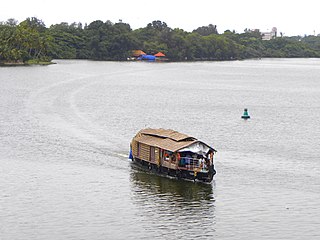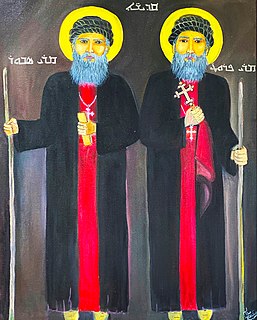
Kollampronunciation (help·info), known by its former name Quilonpronunciation (help·info) and Coulão, and Desinganadu, is an old seaport and city on the Laccadive Sea coast of the Indian state of Kerala. It is situated 66 kilometers north of the state capital Trivandrum. The city is on the banks of Ashtamudi Lake. Kollam has a strong commercial reputation since the days of the Phoenicians and Romans. Fed by the Chinese trade, it was mentioned by Ibn Battuta in the 14th century as one of the five Indian ports he had seen during the course of his twenty-four-year travels. Desinganadu's rajas exchanged embassies with Chinese rulers while there was a flourishing Chinese settlement at Kollam. In the 9th Century, on his way to Canton, China, Persian merchant Sulaiman al-Tajir found Kollam to be the only port in India visited by huge Chinese junks. Marco Polo, the Venetian traveller, who was in Chinese service under Kublai Khan in 1275, visited Kollam and other towns on the west coast, in his capacity as a Chinese mandarin. Kollam is also home to one of the seven churches that were established by St Thomas.

Padmanabhapuram Palace, also known as Kalkulam Palace, is a Travancore era palace located in Padmanabhapuram in the Kanyakumari district of the Indian state of Tamil Nadu. The palace is owned, controlled and maintained by the government of the neighbouring state of Kerala. This palace is older than Rambagh Palace in Rajasthan. May be this is the oldest palace in India.

Fort Thomas or St. Thomas Fort or Fortaleza da São Tomé also known as Tangasseri Fort, is a ruined fort located in the beach town of Tangasseri on the shores of the Arabian Sea in the city of Kollam, Kerala, India. It is located around 5 kilometres (3.1 mi) from the city center of Kollam and 71 kilometres (44 mi) from the state capital Thiruvananthapuram.

Kollam Junction railway station is a junction station situated in the city of Kollam in Kerala, India. It is the second largest railway station in Kerala in terms of area and one of the oldest railway stations in the state. World's second longest railway platform is situated at Kollam railway station.

The Kollam–Sengottai railway line is a railway line in South India which connects Kollam Junction in Kerala state and Sengottai in Tamil Nadu. The Quilon–Shencottah railway line was the first railway line in the erstwhile Travancore state and is more than a century old. The Kollam–Sengottai section is part of the Kollam–Chennai metre-gauge rail route commissioned by the British in 1904. The line has been completely converted to broad gauge and is now fully operational from Kollam Junction to Shengottai.

Kollam Port is one of the historic ports situated 4 kilometres (2.5 mi) away from Downtown Kollam ,14km north of Paravur and 24km north of Varkala Town It is the second largest port in Kerala by volume of cargo handled and facilities. Located on the south-west coast of India, under the name of Quilon Port it became one of the country's most important trade hubs from the ninth to the seventeenth centuries. Kollam was one the five Indian ports visited by Ibn Battuta.

The Asramam Maidanam or Ashramam Maithanam is an urban park, or maidhanam, in the city of Kollam, in Kerala, India. At 72 acres (29 ha), it is the largest open space within Kerala Municipal Corporation limits. The maidan is considered as one of the green lungs of the city and regularly hosts the city's main cultural and sports events. It holds an adventure park children's park, picnic village, British Residency and mangrove forests making it an important tourism spot in the city.

Thevally is located in the city of Kollam, in the state of Kerala, India. Ashtamudi Lake is situated in the vicinity. National Highway-183 passes through the neighbourhood.

The British Residency, also known as the Government Guest House or Residency Bungalow, is a two-storeyed palace situated at Asramam in the city of Kollam in the Indian state of Kerala. It lies close to the site of the old Kollam Airport situated at Asramam in the city and was built by Colonel John Munro between 1811 and 1819. It is a noted Kollam landmark like the Chinnakada Clock Tower.

Chamakada or Chamakkada is one of the trade hubs of the city of Kollam, India. It is an important neighbourhood in the city and is located at the core Downtown Kollam area. The area is very famous for wholesale dealers and rice merchants. The local retail dealers are filling the stocks regularly from Chamakada-based wholesale dealers. So many bank branches, godowns, store rooms, printing presses, automobile spare parts stores, courier services etc. are located at Chamakada area. Chamakada is the second main commercial centre of Kollam city after Chinnakada. So many famous restaurants also located at Chamakada.

Kollam Cantonment is a residential neighbourhood in the city of Kollam. It arose as a cantonment of the British Raj in the 17th century. It is now a thickly populated area of the city of Kollam. Some of the important business centres, shopping complexes and Government offices are located here. Kollam Junction railway station is also located near to cantonment area.

Transport in Kollam includes various modes of road, rail and water transportation in the city and its suburbs. State-owned Kerala State Road Transport Corporation buses, private buses, Indian Railways, state-owned Kerala State Water Transport Department boats & ferry, taxis and auto rickshaws are serving the city of Kollam. The city had a strong commercial reputation since the days of the Phoenicians and Romans. Ibn Battuta mentioned Kollam Port as one of the five Indian ports he had seen during the course of his twenty-four year travels.

Crowther Masonic Hall or Freemasons' Hall in Kollam is a part of the Grand Lodge of India and it was a meeting place for many Masonic Lodges in the Quilon (Kollam) area. It is near Kochupilamoodu in Kollam city and has been a Masonic meeting place since 1806. The building is now considered as a historic monument of Freemasonry activities in ancient Travancore area.
A.D.Cotton or Parvathi Mills Limited is a textile manufacturing company owned by the National Textile Corporation (NTC) in Kollam city, India. The company was founded in 1884 by British citizen A.D. Cotton and was the lifeline of Kollam before independence. This mill was taken for rent for running by a Tamil enterpriser after Independence as the land was owned by the Kerala State Textile Corporation at that time. It was later was handed over to the NTC. The company has 120 employees, six of which are NTC staffers and 17 are casual workers. The plant has been shut down since 2008 pending modernisation. However, there is demand to build a bird sanctuary connected to backwaters.
Buckingham Canal in Kollam is a 450-year-old Portuguese built heritage landmark at Tangasseri. It is one of the rare existing ancient remnants in city of Kollam (Quilon) - Commercial Capital of ancient Malabar coast. The Canal is believed to be a key conduit built by the Portuguese some 450 years ago inside their strategic territory, the Fort Thomas. Quilon along with Tangasseri was one among the ancient Portuguese settlements in Asia.

Kollam Canal or Quilon Canal or Kollam Thodu is a 7.7 km long canal system passing through the city of Kollam, India. It is a part of National Waterway-3 and 78 km long Kollam-Trivandrum (Kovalam) State waterway project.

Kollam–Thiruvananthapuram trunk line is a railway line in Southern Railway zone connecting the cities of Kollam and Thiruvananthapuram in the state of Kerala, India. The line was opened on 4 January 1918 as the extension of Madras–Quilon line during metre gauge era.

The Eight-point Gallery Cafe or 8 Point Art Cafe is an art gallery and cafe situated in Kollam (Quilon) city of Kerala, India. This is the first international standard art cafe in the city of Kollam. Eight-Point is established in a renovated heritage building, ‘Parambarya,’ inside the Asramam Picnic Village campus. Famous muralist and art director Mr. Shenley had taken the Parambarya building from Kollam DTPC(District Tourism promotion Council) for five years to set-up this art cafe. The Kollam DTPC has spent nearly 2 million Indian Rupee for the renovation and setting up of properties in the museum/Paramparya building.

Quilon or Coulãopronunciation (help·info), officially Kollampronunciation (help·info) is one of the ancient civilizations in India. It is one of the oldest port cities in the Malabar Coast and was the capital city of historic Venad Kingdom and Travancore Kingdom. Quilon was once an important trading port in India. It was also known as Desinganadu. It is now known as the "Cashew Capital of the World".

City of Kollam or Quilon is a Port city in South India and was the commercial capital of erstwhile Kingdom of Travancore. It is situated on the Laccadive Sea coast of South Kerala. The city is known as the "Gateway to the backwaters of Kerala". The city lies on the banks of Ashtamudi Lake, Kerala's second largest lake, on the Arabian sea coast. Major parts of Kollam city are covered by Ashtamudi Lake.


















